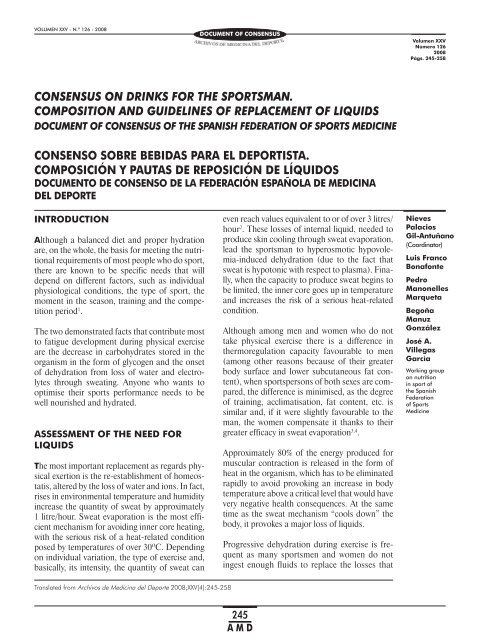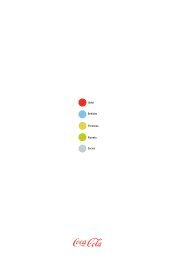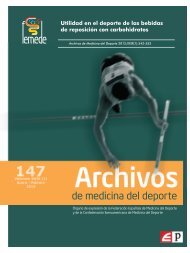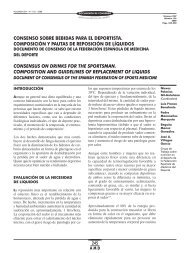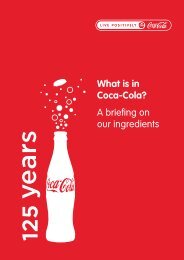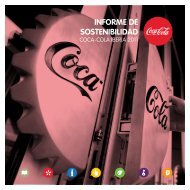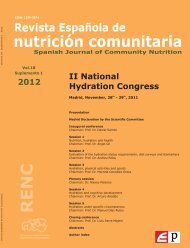de medicina del deporte - femede
de medicina del deporte - femede
de medicina del deporte - femede
Create successful ePaper yourself
Turn your PDF publications into a flip-book with our unique Google optimized e-Paper software.
VOLUMEN XXV - N.º 126 - 2008DOCUMENT OF CONSENSUSCONSENSUS ON DRINKS FOR THE SPORTSMAN. COMPOSITION AND GUIDELINES OF REPLACEMENT Volumen OF LIQUIDS XXVNúmero 1262008Págs. 245-258CONSENSUS ON DRINKS FOR THE SPORTSMAN.COMPOSITION AND GUIDELINES OF REPLACEMENT OF LIQUIDSDOCUMENT OF CONSENSUS OF THE SPANISH FEDERATION OF SPORTS MEDICINECONSENSO SOBRE BEBIDAS PARA EL DEPORTISTA.COMPOSICIÓN Y PAUTAS DE REPOSICIÓN DE LÍQUIDOSDOCUMENTO DE CONSENSO DE LA FEDERACIÓN ESPAÑOLA DE MEDICINADEL DEPORTEINTRODUCTIONAlthough a balanced diet and proper hydrationare, on the whole, the basis for meeting the nutritionalrequirements of most people who do sport,there are known to be specific needs that will<strong>de</strong>pend on different factors, such as individualphysiological conditions, the type of sport, themoment in the season, training and the competitionperiod 1 .The two <strong>de</strong>monstrated facts that contribute mostto fatigue <strong>de</strong>velopment during physical exerciseare the <strong>de</strong>crease in carbohydrates stored in theorganism in the form of glycogen and the onsetof <strong>de</strong>hydration from loss of water and electrolytesthrough sweating. Anyone who wants tooptimise their sports performance needs to bewell nourished and hydrated.ASSESSMENT OF THE NEED FORLIQUIDSThe most important replacement as regards physicalexertion is the re-establishment of homeostatis,altered by the loss of water and ions. In fact,rises in environmental temperature and humidityincrease the quantity of sweat by approximately1 litre/hour. Sweat evaporation is the most efficientmechanism for avoiding inner core heating,with the serious risk of a heat-related conditionposed by temperatures of over 30ºC. Dependingon individual variation, the type of exercise and,basically, its intensity, the quantity of sweat caneven reach values equivalent to or of over 3 litres/hour 2 . These losses of internal liquid, nee<strong>de</strong>d toproduce skin cooling through sweat evaporation,lead the sportsman to hyperosmotic hypovolemia-induced<strong>de</strong>hydration (due to the fact thatsweat is hypotonic with respect to plasma). Finally,when the capacity to produce sweat begins tobe limited, the inner core goes up in temperatureand increases the risk of a serious heat-relatedcondition.Although among men and women who do nottake physical exercise there is a difference inthermoregulation capacity favourable to men(among other reasons because of their greaterbody surface and lower subcutaneous fat content),when sportspersons of both sexes are compared,the difference is minimised, as the <strong>de</strong>greeof training, acclimatisation, fat content, etc. issimilar and, if it were slightly favourable to theman, the women compensate it thanks to theirgreater efficacy in sweat evaporation 3,4 .Approximately 80% of the energy produced formuscular contraction is released in the form ofheat in the organism, which has to be eliminatedrapidly to avoid provoking an increase in bodytemperature above a critical level that would havevery negative health consequences. At the sametime as the sweat mechanism “cools down” thebody, it provokes a major loss of liquids.Progressive <strong>de</strong>hydration during exercise is frequentas many sportsmen and women do notingest enough fluids to replace the losses thatNievesPalaciosGil-Antuñano(Coordinator)Luis FrancoBonafontePedroManonellesMarquetaBegoñaManuzGonzálezJosé A.VillegasGarcíaWorking groupon nutritionin sport ofthe SpanishFe<strong>de</strong>rationof SportsMedicineTranslated from Archivos <strong>de</strong> Medicina <strong>de</strong>l Deporte 2008;XXV(4):245-258245A M D


